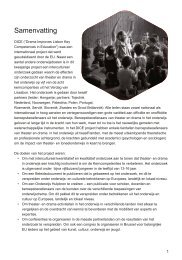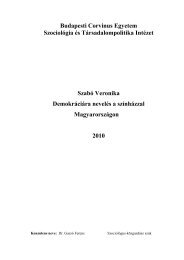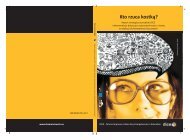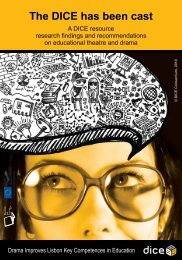Education Resource - Drama Improves Lisbon Key Competences in ...
Education Resource - Drama Improves Lisbon Key Competences in ...
Education Resource - Drama Improves Lisbon Key Competences in ...
- No tags were found...
Create successful ePaper yourself
Turn your PDF publications into a flip-book with our unique Google optimized e-Paper software.
Documented practicesroom by the girl <strong>in</strong> Malta creates a unity of sites A and B <strong>in</strong> the workshop. Site B providesthe logic of the situation, of the drama, which is why we build the room and the street withreal attention to detail.Site C is the means by which Sites A and B are conveyed to the audience (site D). Thisis through the story, objects, images and actions. And this is critical to the workshop onmany levels. The focus is on the objects <strong>in</strong> the situation rather than the ‘character’ of theMan, because we are focused on the situation embodied <strong>in</strong> our story and our objects.The objects use us as much as we use them: it’s the paradox of our culture. The objects<strong>in</strong> the workshop are used <strong>in</strong> relation to the story, or text, <strong>in</strong> order to create a gap for theaudience to fill with mean<strong>in</strong>g. We do this by cathect<strong>in</strong>g the objects.Bond calls this a <strong>Drama</strong> Event, a DE. A DE occurs when objects that are ideologicallyneutral or where the ideological content is strik<strong>in</strong>g <strong>in</strong> a given dramatic situation, aredeconstructed by cathexis and decathexis. This process charges/imbues the objectwith mean<strong>in</strong>g (and energy) and value that extend beyond the th<strong>in</strong>g itself and penetrateideologically-given mean<strong>in</strong>gs <strong>in</strong> order to reveal to us what was previously concealed – theobjective situation (also known as the Invisible Object).In the open<strong>in</strong>g dramatic sequence presented to the participants, the suitcase is cathexedfrom be<strong>in</strong>g an everyday object to someth<strong>in</strong>g else, an almost personified human presence,not yet fully def<strong>in</strong>able but imbued with a different set of values from those that wenormally associate with the object. There is a tension between the received mean<strong>in</strong>gascribed to the object <strong>in</strong> everyday life (which still rema<strong>in</strong>s) and the new values <strong>in</strong>vested<strong>in</strong> it. The suitcase is constantly cathexed and recathexed; transformed from a suitcaseto someth<strong>in</strong>g/body that, <strong>in</strong> the words of the participants, the Man ‘wants to talk to butcan’t’ because he can’t yet access his own story, his own ‘self’. For the participants, thesuitcase holds ‘his memories’, ‘a part of himself that he’s ashamed of’. It is someth<strong>in</strong>g that‘he wants to bury himself <strong>in</strong>’, someth<strong>in</strong>g ‘he wants to keep out’ or ‘keep secret’ because‘he is frightened of the world’ and ‘he has noth<strong>in</strong>g left he can believe <strong>in</strong>.’ On the occasionthat one of the participants force-fed and beat the suitcase we had found the <strong>in</strong>visibleobject of our drama. Objects become <strong>in</strong>credibly powerful <strong>in</strong> the site because, by be<strong>in</strong>gdramatised, they are not operat<strong>in</strong>g primarily as metaphor or symbol but metonymically –the suitcase actually embodies these th<strong>in</strong>gs. It is the logic of the imag<strong>in</strong>ation.This creates the gap. It is an extreme situation. The facilitator does not fill it with wordsof explanation, however. It requires the audience to make mean<strong>in</strong>g of this <strong>in</strong> time andspace by enter<strong>in</strong>g <strong>in</strong>to the site imag<strong>in</strong>atively. This is site D, the site of the audience asimag<strong>in</strong>ation, the site of the ‘self’. By feed<strong>in</strong>g and beat<strong>in</strong>g the suitcase, the boy <strong>in</strong> questionwas seek<strong>in</strong>g reason (for the Man’s situation) imag<strong>in</strong>atively. He was explor<strong>in</strong>g the logic ofthe situation and <strong>in</strong> do<strong>in</strong>g so he was engaged <strong>in</strong> an act of self creation by test<strong>in</strong>g his ownvalues. This is why the emphasis is on experience rather than reflection, on enactmentrather than act<strong>in</strong>g. Act<strong>in</strong>g closes down mean<strong>in</strong>g. Enactment opens mean<strong>in</strong>g up. It iscloser to play than theatrical convention; it is the imag<strong>in</strong>ation <strong>in</strong> action. And it is throughthe imag<strong>in</strong>ation that we connect with the basis of our humanness.j. Further read<strong>in</strong>gBakhurst David & Christ<strong>in</strong>e Sypnowich (eds) (1995) The Social Self, Sage PublicationsBolton, Gav<strong>in</strong> (1998) Act<strong>in</strong>g <strong>in</strong> Classroom <strong>Drama</strong>: a critical analysis, Trentham BooksBond, Edward (2000) The Hidden Plot: Notes on Theatre and the State, MethuenDaniels, Harry (2001) Vygotsky and Pedagogy, RoutledgeFalmerDavis, David (ed.) (2005) Edward Bond and the <strong>Drama</strong>tic Child, Trentham BooksDavis, David (2009) Introduction to Saved by Edward Bond, Methuen <strong>Drama</strong> studentsedition.Elliott, Anthony (2008) Concepts of the Self, Polity PressJohnson, Liz and Cecily O’Neill (eds) (1984) Collected Writ<strong>in</strong>gs on <strong>Education</strong> and<strong>Drama</strong> – Dorothy Heathcote, HutchisonVygotsky, Lev S. (1978) M<strong>in</strong>d <strong>in</strong> Society – The Development of Higher PsychologicalProcesses, Harvard University Pressk. Teachers: A guide to practiceRecommendations, issues and questions to considerIf you are <strong>in</strong>terested <strong>in</strong> us<strong>in</strong>g this workshop or adapt<strong>in</strong>g elements of it to your own contextwe would take the follow<strong>in</strong>g <strong>in</strong>to consideration:Content: The Suitcase workshop was created primarily because Big Brum have anongo<strong>in</strong>g <strong>in</strong>terest <strong>in</strong> some core ideas that we wanted to explore with young people. Wehave been explor<strong>in</strong>g aspects of this core for a number of years <strong>in</strong> different forms. Theneed return to these ideas is an expression of an artistic drive that exists with<strong>in</strong> thecompany both <strong>in</strong>dividually and collectively. This drive is critical to successful practice.If you are driven to want to explore the centre of Suitcase with a similar or differentstructure it will be a major step forward and will furnish you with the necessary fortitudeto withstand the <strong>in</strong>evitable struggles and set-backs you will experience if you are new towork<strong>in</strong>g <strong>in</strong> this way. If the drive does not exist, we recommend you f<strong>in</strong>d someth<strong>in</strong>g elsethat fasc<strong>in</strong>ates you or that you feel passionate about as a start<strong>in</strong>g po<strong>in</strong>t; that way you willf<strong>in</strong>d it easier to structure lessons that will engage young people.In educational theatre and drama one has to consider the dual function of work<strong>in</strong>g asan artist and educator. Our experience tells us, however, that unless you are function<strong>in</strong>gDocumented practices4445







